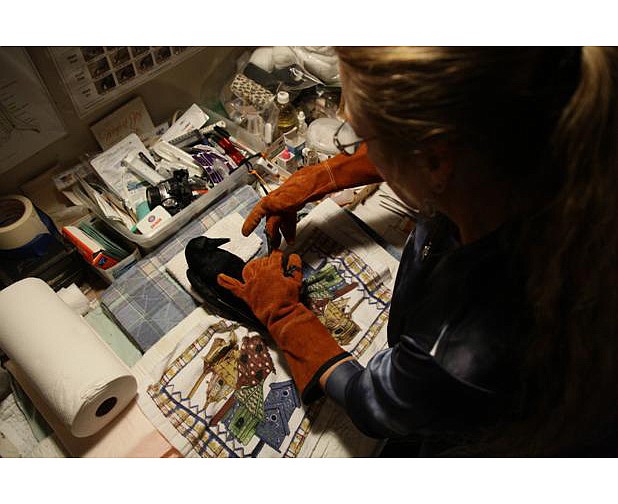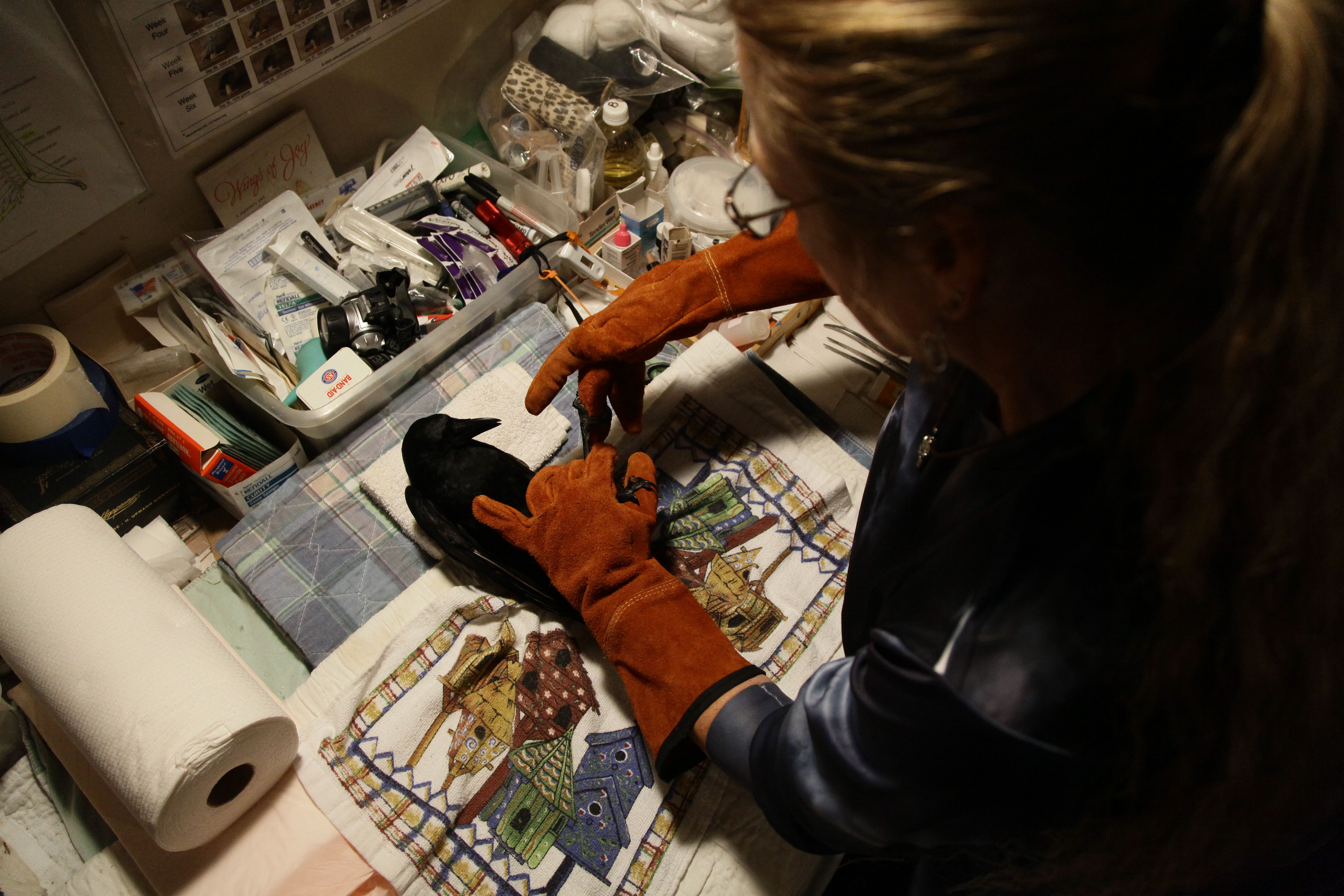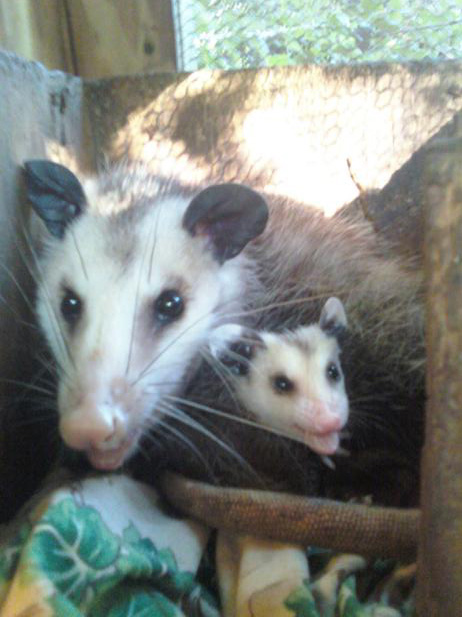WHOM TO CALLShould you encounter an injured or potentially orphaned wild animal, call or visit websites for the appropriate wildlife management agency and a list of permitted rehabilitators:* Tennessee: Tennessee Wildlife Resources Agency Law Enforcement, 615-781-6647 or www.tn.gov/twra/wildliferehab.html.* Georgia: Georgia Department of Natural Resources Special Permit Unit, 770-761-3044 or www.georgiawildlife.com/node/414.* Alabama: Alabama Department of Conservation and Natural Resources Wildlife and Freshwater Fisheries Division, 334-242-3465 or www.dcnr.state.al.us.* North Carolina: North Carolina Wildlife Resources Commission License Section, 1-888-248-6834 or www.ncwildlife.org.JOIN THE RANKSRequirements to attain a wildlife rehabilitation permit vary slightly from state to state, but the major criteria include:• Passing a written exam.• Demonstrate working knowledge with the intended species. In Tennessee, potential rehabilitators must record 200 hours of apprenticeship. Veterinarians and veterinary technicians automatically are considered to have met this requirement.• Having their proposed facilities inspected prior to approval.• Letters of reference and competency from veterinarians, wildlife officers or other qualified individuals.• A separate, federal permit from the U.S. Department of Fish and Wildlife is required, in addition to a state permit, for those who want to treat migratory birds.IF YOU SEE A WILD ANIMALMost rehabilitators say they begin seeing new patients with the onset of spring and the breeding season. To prevent unnecessary harm to native wildlife, rehabilitators suggest the following:• Limit cat attacks of songbirds by putting a bell on your cat and keeping it indoors or allowing it outside only at night, especially during June and July.• If a bird is attacked, place it in a large paper bag with holes for ventilation and call a veterinarian or wildlife agency for contact info for the appropriate rehabilitator• If you see a turtle about to cross a busy road, pick it up and place it on the opposite side of the street in the direction it was heading.• Contact a rehabilitator if you encounter turtles with large lumps on its body, a recently damaged shell or sunken, cloudy eyes.• Avoid picking up young wild animals, even if they seem abandoned. The mother is most likely nearby and will return. Contact a rehabilitator only if the baby is clearly injured or the parents do not return for six hours or more.• Encourage unwelcome animals on your property to leave by non-lethal "hazing" -- pointing a strong flashlight and loud radio into their den.• If in doubt, call a rehabilitator.
Reaching into a wooden birdhouse in the 30-foot, latticework-enclosed aviary behind her Signal Mountain home, Alix Parks jerks her hand back, narrowly avoiding a nip from Al, a screech owl huddled inside.
Chuckling over his warning beak clicks, Parks, a state-certified wildlife rehabilitator, closes the birdhouse's lid and retreats into the adjacent garage to find a pair of protective gloves. Al's unsuccessful bite, she says, is an indication that he is almost mended after arriving at her home following a recent collision with a tractor-trailer traveling from Virginia.
"[Wild animals] don't like us," Parks says, picking up the eight-inch-tall, russet-colored owl in her now-glove-covered hands. "But that's a good sign. It shows they're afraid of man."
Parks is a member of a nationwide network of individuals who volunteer their time and money, often without compensation, to help injured native animals recuperate before releasing them back into their natural habitat. In the Chattanooga area, there about a dozen such caregivers, each with their own specialty, be it birds or mammals such as squirrels, possums, rabbits, raccoons or deer.
Parks' particular passion is for birds of prey, a focus that has earned her the nickname "The Raptor Lady." Other local caregivers have similar monikers -- The Bunny Lady, The Possum Lady.
A pet-sitter by day, Parks saved for years to turn her home into a rehabilitation center that includes a trauma center and supply depot in her former garage and an even larger, 80-foot aviary she added to the side of her house in 2010 for larger birds.
Despite far exceeding the 50-foot minimum required by the state, Parks says she wishes the aviary were even bigger. That way, Isis and Pharoah, two vultures who currently are its only residents, would have even more room to fly.
"I wish it was 100 feet," she says, the vultures warily flapping 12 feet overhead from one Astroturf-covered wooden perch to another. "You can never have a big enough cage because it's not the wild; it's not the sky."
HOME CLINICS
The requirements to be permitted as a wildlife rehabilitator differ in Georgia and Tennessee, but getting hawks back into the sky, squirrels into the trees and turtles back into the marshlands are the top priorities for the dozens who tend to animals in each state.
That's also the guiding principle behind issuing the licenses to begin with, says Walter Cook, the Tennessee Wildlife Agency's notoriously exacting captive wildlife coordinator.
"If an animal is injured or sick and someone wants to provide competent care -- at no expense to the state -- to put it back out in the wild, then we're meeting our mandate to manage wildlife," Cook explains.
By state law, anyone, including veterinarians and zoos, must have separate, inspected facilities before they're allowed to work with wildlife. Many lack the space and staff necessary to deal with the influx of wildlife, which is where rehabilitators step in, says Tish Gailmard, a Signal Mountain resident and rehabilitator specializing in the care of opossums and squirrels
Injured wildlife come to rehabilitators from many sources. Some are picked up on the side of the road or reported as being entangled in fencing; some come from veterinarians. Tennessee and Georgia maintain online lists of registered rehabilitators and, when a wild animal arrives at an non-permitted facility, a local specialist often is called in to take over.
Since 1994, Cook says, Tennessee has maintained a force of about 75 rehabilitators, five of whom are based in Hamilton County. Georgia currently permits about 95 rehabilitators, although only handful are in North Georgia counties such as Fannin, Gilmer and Floyd and none in Walker, Whitfield or Catoosa.
Maj. Stephen Adams, the head of the rehabilitation program at the Georgia Wildlife Resources Agency, says the agency doesn't seek out rehabilitators and hasn't heard an outcry for more in North Georgia. If a qualified individual were to apply, however, they probably would be permitted.
"It's not something where we've felt like there was a void," Adams says.
State permits limit treatment to native wildlife, and permittees are allowed to rehabilitate any native species, excluding potential rabies carriers such as bats, raccoons, skunks, foxes and coyotes. For about a decade, wildlife rehabilitation permits allowed the treatment of rabies carriers, but in response to the first appearance of the disease in Tennessee in 2003, those animals were excluded from the state's program in 2004. In 2007, based on input from rehabbers, the state implemented additional requirements for those who want special authorization to treat rabies carriers.
Rehabilitators' facilities are inspected by the state in two- or three-year intervals, and strict regulations are in place to prevent wounded animals interaction with other animals and to limit the time they spend in captivity.
Hamilton County's rehabilitators say Cook is a precise overseer of the program, but when it comes to potentially transmitting diseases between species or endangering native wildlife, the rules are there for a reason, he says.
"Disease is the No. 1 threat to wildlife management in North America today," Cook explains. "If you don't follow the rules, you can end up with a real problem, and I don't think anyone wants to be responsible for it."
'WILD THEM UP'
A rehabilitated animal is only supposed to be held until it is capable of surviving on its own, but the criteria for declaring an animal fit for release varies.
Amphibians and reptiles may over-winter with a rehabber but must be released when the weather warms. Raptors should be able to fly without issue and hunt live prey independently.
A squirrel must be able to stand on its hind legs and crack a hard-shell nut. Opossums should demonstrate a keen sense of smell and seek out natural food sources.
The term limits are in place to keep animals from becoming too accustomed to humans, says Maj. Stephen Adams, the head of the rehabilitation program at the Georgia Wildlife Resources Agency.
"We don't allow the rehab animal to become a pet," explains Adams. "The rehabber's purpose is to bridge the gap between it being sick or injured and being released. Being imprinted on humans is not part of that."
"People get mixed up in their mind that they're like pets, but they're not," explains Sheryl Leitner, a bird rehabilitator who lives downtown in Fort Wood. "The purpose is that they 'wild up' so you can release them out."
Rehabilitators come from a range of backgrounds. Some have professional training as a veterinarian, veterinary technician or physician. Others were apprenticed unofficially by another caregiver.
Most in Hamilton County work out of their homes, but some permits have been issued to existing facilities such as zoos or veterinary clinics, so long as they provide a bio-secure area to prevent contact with other animals.
Currently, the Chattanooga Zoo is one of two zoos in the state that is licensed to take in and rehabilitate native wildlife; the other is the Memphis Zoo, which specializes in eagles. The zoo takes in 600 to 800 animals a year in an off-site facility that is quarantined to prevent cross-contamination with the zoo's collection. the rehabilitation staff simply stabilizes the majority of these animals before sending them to one of the local rehabilitators. Some of the zoo's own collection came from rehabilitated animals that could not be returned to the wild.
About two years ago, the zoo started a grant system to provide some financial assistance to local rehabilitators, and the zoo steps in when it can to provide supplies that otherwise are paid for out-of-pocket. Chattanooga Zoo Executive Director Darde Long says rehabilitators serve a vital function, often without receiving any recognition or compensation, and the grants were a way of giving back.
"It's a tight-knit community and a very, very dedicated community," she says. "There's a lot of wildlife out there that finds itself in the wrong place at the wrong time and in need of care. That's what rehabilitation is all about."
Even with the assistance from the zoo, rehabilitation can be hard and never-ending work, especially during the busy season, which runs February to October. On average, local rehabilitators treat about 100 animals during that time and the reward for the long hours of cleaning and feeding, out-of-pocket expenses and the emotional toll of euthanizing the critically injured is when a recuperated patient soars, hops or crawls away without looking back.
Despite sharing a love of animals that usually stretches back to childhood, rehabilitators follow many paths to the job.
Parks decided to begin helping injured birds after a startled hawk literally dropped its prey, an injured grackle, on her head while she was hiking. She nursed the grackle back to health, then turned her attention to caring for the falcons to which it fell prey.
In Leitner's case, she became passionate about returning baby birds to their homes after her own nest emptied.
"I raised four kids ... and when they left for college, I ended up going back to the thing that gave me the most satisfaction, which was helping creatures," she says. "It takes a long time to raise a kid, and then you release them into society. With a little animal, it takes a month or two, and ... it gives you a sense of satisfaction that they can make it on their own, but it takes a lot less time."
KILLING WITH KINDNESS
The reason most animals end up with a rehabilitator is because they ran afoul of man, but the culprit isn't always rat poison or a collision with a vehicle. Even good Samaritans with the animal's welfare at heart can cause problems.
When people see an injured animal, the immediate thought often is to take it home and care for it themselves, but doing so is illegal. Treating a wild animal without a permit is punishable by up to a year in jail and a fine of $1,000 in Georgia and $2,500 in Tennessee.
It also can cause more harm than good, rehabilitators say. With the onset of spring, rehabilitators say they expect a rush of calls from people who have taken in an infant animal they assume has been abandoned by its parents. Ultimately, the result isn't rescue so much as kidnapping, Gailmard says.
Misconceptions about wildlife sometimes also can have deadly consequences for the creature.
Leitner says she took in a squirrel that had been kept too long by its rescuers, who fed it on a diet of Cheerios. It was tame and, when an animal loses its wild instincts, rehabilitators seek to place it in a educational exhibition. Failing that, the result often is euthanasia.
"We weren't able to wild it up ... because it didn't know how to forage for itself because of the improper diet," Leitner says. "People with kind hearts end up doing more damage."
Rehabilitators' survival rates vary widely. Some say they are happy if half the animals they care for ultimately return to the wild. Sometimes, a seemingly healthy animal will appear ready for release in the evening only to die overnight.
"It's hard and sad when an animal dies," Gailmard says. "You start to think, 'What am I doing wrong?' But then you know that you're trained, you know what you're doing and you're doing everything you can."
In some cases, treatment isn't an option. Some animals are dead on arrival or beyond the hope of recovery. In those cases, easing its passing often is the only course left.
Rehabilitation, Parks says, can be like running an emergency room.
"I know people who would like to do rehabilitation, but I don't think they'd be able to because you have to be just flint-hard a lot of times," she says.
MAKING A DIFFERENCE
Rehabilitators say they recognize that their efforts to save individual animals will probably not impact the species as a whole, but every successful release is significant.
Danny Patterson has been raising fawns at his home near McCaysville, Ga., for more than 20 years. A lifelong hunter, he says he decided that, if he was going to take deer from the wild, he had to find a way to balance things out.
"I figure that if I don't put back, then I'm ... actually hurting the population," he says. "I just have a heart for the little deer."
So far, he has raised about 30 fawns, most of which were abandoned or orphaned. Before he married, he says he would bring them into his bedroom at night. When they needed to feed, the fawns would try to climb in the bed with him until he fed them from a bottle he kept on the nightstand.
"You have to keep it clean all the time and keep them fed," he says. "It's enjoyable but it's a headache. It's like raising a baby."
Every year, Patterson begins taking in fawns during the spring for release at the onset of fall. That happens to coincide with hunting season, but he says he doesn't worry, since he hasn't hunted near his property since he began rehabilitating them.
"I just turn them loose and hope for the best," he says.
At Parks' aviary, Al the screech owl doesn't fly very well and his beak is overgrown, so his prospects of release aren't promising. Parks says she hopes to find a home for him in an educational exhibit such as the Chattanooga Nature Center.
Rehabilitation may be about saving wild animals, but when one of her patients returns to its natural habitat, the relief flows both ways, Parks says.
"We give them their second chance, their second chance at life," she says. "Just knowing that bird is going to live its life in the wild like it should be is a great feeling -- the best."



